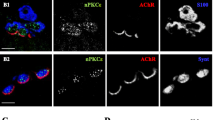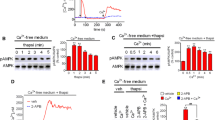Abstract
Anti-peptide antibodies specific for each protein kinase C (PKC) isozyme were used to screen SKN-SH human neuroblastoma cells. These cells were found to express only α- and ζ-PKC. Stimulation of these cells with phorbol esters caused α-but not ζ-PKC to translocate from cytosolic to membrane fractions. Stimulation of these cells with carbachol, which releases inositol trisphosphate and diacylglycerol, caused a transient translocation of α-PKC but not of ζ-PKC. Carbachol did, however, cause a gradual increase in immunoreactive ζ-PKC which reached maximal values 10–20 min after stimulation. These results implicate ζ-PKC in a receptor-mediated signalling event.
Similar content being viewed by others
References
Nishizuka, Y. 1988. The molecular heterogeneity of protein kinase C and its implications for cellular regulation. Nature 334:661–665.
Liyanage, M., Frith, D., Livneh, E., and Stabel, S. 1992. Protein kinase C group B members: comparison of properties of recombinant proteins in vitro and in vivo. Biochem. J. 283:781–787.
Parker, P. J., Coussens, L., Totty, N., Rhee, L., Young, S., Chen, E., Stabel, S., Waterfield, M. D., and Ullrich, A. 1986. The complete primary structure of protein kinase C-the major phorbol ester receptor. Science 233:853–866.
Stabel, S., and Parker, P. J. 1991. Protein kinase C. Pharmac. Ther. 51:71–95.
Ono, Y., Fuji, T., Igarashi, K., Kuno, T., Tanaka, C., Kikkawa, U., and Nishizuka, Y. 1989. Phorbol ester binding to protein kinase C requires a cystein rich zinc-finger-like sequence. Proc. Natl Acad. Sci. USA 86:4868–4871.
Ono, Y., Fujii, T., Ogita, K., Kikkawa, U., Igarashi, K., and Nishizuka, Y. 1989. Protein kinase C ζ subspecies from rat brain: Its structure, expression and properties. Proc. Natl. Acad. Sci. USA 86:3099–3103.
Ways, D. K., Cook, P. P., Webster, C., and Parker, P. J. 1992. Effect of phorbol esters on protein kinase C-ζ. J. Biol. Chem. 267:4799–4805.
Fisher, S. K., and Heacock, A. M. 1988. A putative M3 muscarinic cholinergic receptor of high molecular weight couples to phosphoinositide hydrolysis in human SK-N-SH neuroblastoma cells. J. Neurochem. 50:984–987.
Baumgold, J., and White, T. 1989. Pharmacological differences between muscarinic receptors coupled to phosphoinositide turnover and those coupled to adenylate cyclase inhibition. Biochem. Pharmacol. 38:1605–1616.
Baumgold, J., Paek, R., and Fiskum, G., 1992. Calcium-independence of phosphoinositide hydrolysis-induced increase in cAMP accumulation in SK-N-SH human neuroblastoma cells. J. Neurochem. 58:1754–1759.
Yu, V. C., and Sadee, W. 1986. Phosphatidylinositol turnover in neuroblastoma cells: regulation by bradykinin, acetylcholine, but not μ and δ opioid receptors. Neurosc. Letters 71:219–223.
Baumgold, J., Paek, R., and Yasumoto, T. 1992. Agents that stimulate phosphoinositide turnover also elevate cAMP in SK-N-SH human neuroblastoma cells. Life Sciences 50:1755–1759.
Thomas, T. P., Gopalakrishna, R., and Anderson, W. B. 1987. Hormone and tumor promoter-induced activation of membrane association of protein kinase C in intact cells. Methods in Enzymol. 141:399–412.
Nakanishi, H., Brewer, K. A., and Exton, J. H. 1993. Activation of the ζ isozyme of protein kinase C by phosphatidylinositol 3,4,5-trisphosphate. J. Biol. Chem. 268:13–16.
Dominguez, I., Diaz-Meco, M. T., Municio, M. M., Berra, E., Garcia de Herreros, A., Cornet, M. E., Sanz, L., and Moscat, J. 1992. Evidence for a role of protein kinase C zeta subspecies in maturation of Xenopus laevis oocytes. Mol. and Cell. Biology 12:3776–3783.
Conklin, B. R., Brann, M. R., Buckley, N. J., Ma, A. L., Bonner, T. I., and Axelrod, J. 1988. Stimulation of arachidonic acid release and inhibition of mitogenesis by cloned genes for muscarinic receptor subtypes stably expressed in A9 L cells. Proc. Natl. Acad. Sci. USA 85:8698–8702.
Ashkenazi, A., Ramachandran, J., and Capon, D. J. 1989. Acetylcholine analogue stimulates DNA synthesis in brain-derived cells via specific muscarinic receptor subtypes. Nature 340:146–150.
Author information
Authors and Affiliations
Rights and permissions
About this article
Cite this article
Baumgold, J., Dyer, K.D. Muscarinic receptor-mediated increase in ζ-PKC expression in SK-N-SH human neuroblastoma cells. Neurochem Res 19, 135–138 (1994). https://doi.org/10.1007/BF00966807
Accepted:
Issue Date:
DOI: https://doi.org/10.1007/BF00966807




